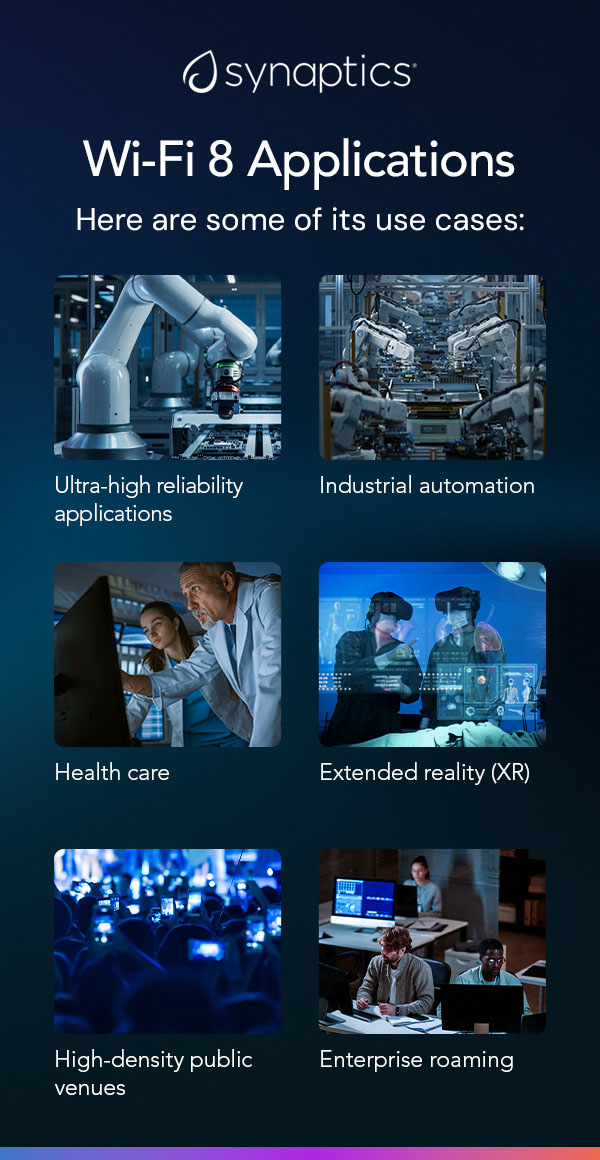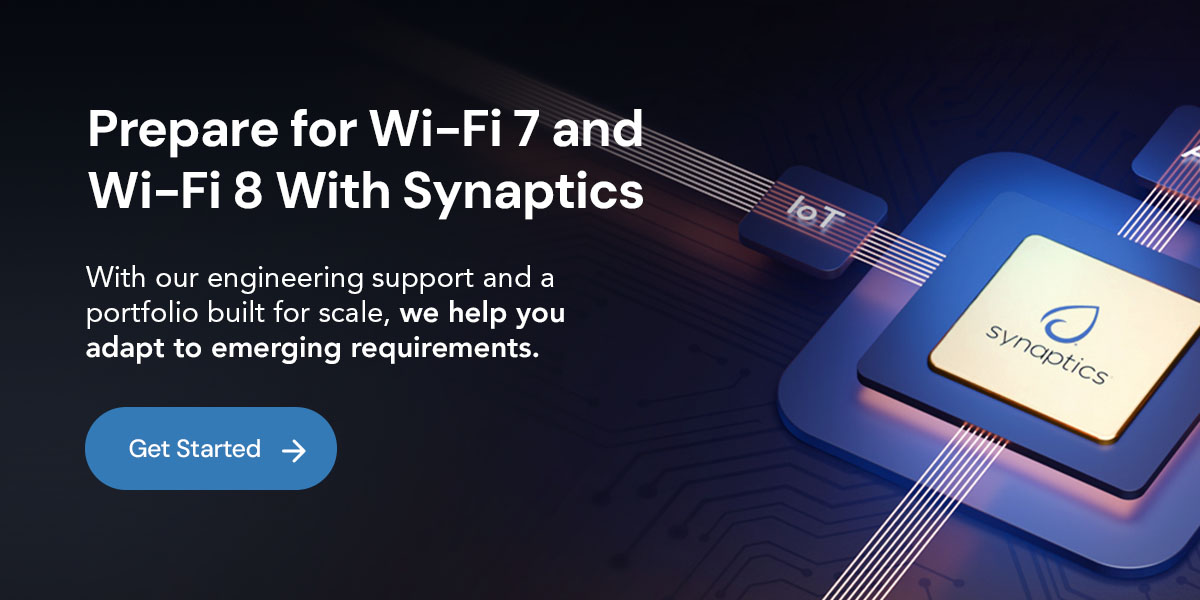Wi-Fi 7 is reshaping how devices communicate, and Wi-Fi 8, with even more advanced capabilities, is on the horizon. Businesses building connected devices need to understand how next-generation Wi-Fi impacts design decisions, user expectations and product viability.
Whether you're developing smart home devices, industrial systems or enterprise-grade solutions, staying ahead of these evolving standards helps you deliver reliable and future-ready products.
Discover the key feature differences between Wi-Fi 7 and Wi-Fi 8, use cases and what this all means for product development.
What Is Wi-Fi 7?
Wi-Fi 7, or standard IEEE 802.11be, is the latest generation of wireless technology with extended capabilities of Wi-Fi 6 and 6E. The standard offers precise coordination, better use of spectrum and enhanced flexibility. Wi-Fi 7 delivers speeds of up to 46 Gbps.
The technology is commercially available in chipsets, routers, access points and adapters. Wi-Fi 7 maintains backward compatibility with Wi-Fi 6 and 6E, making it easier to transition without overhauling existing infrastructure.
Key Features of Wi-Fi 7
Wi-Fi 7 redefines wireless connectivity with robust capabilities that boost efficiency. The features of Wi-Fi 7 include:
320 MHz Channel
Wi-Fi 7 has a channel bandwidth of 320 megahertz (MHz). This additional bandwidth is primarily available in the 6 GHz spectrum and is beneficial in large data load settings, where faster data transfers reduce latency and streamline user experiences.
4096 QAM
Quadrature amplitude modulation (QAM) determines how much data can be encoded into a signal. Wi-Fi 7 moves from 1024 QAM of Wi-Fi 6 to 4096 QAM, meaning more bits are transmitted per signal burst. For product developers, this means less time spent on data handoffs, which improves responsiveness and frees up network resources.
Multi-Link Operation
Multi-link operation (MLO) allows devices to operate across the 2.4 GHz, 5GHz and 6GHz bands simultaneously or dynamically. This flexibility reduces congestion, balances traffic and adds redundancy for stable connections.
MLO modes include:
- Multi-link single radio: Allows a user to alternate bands but receive only one frequency spectrum at a time.
- Multi-link multi-radio: Allows for simultaneous and non-simultaneous transmission using two or more radios to operate across bands.
- Enhanced multi-link single radio: Allows transmission on only one band at a time but adds more intelligence to how the device switches between frequency ranges.
Multiple Resource Units
Wi-Fi 7 introduces flexible ways to allocate spectrum through multiple resource units (MRUs). These resource units allow a single device to pull together fragmented portions of the channel to form a usable transmission path. For environments with mixed traffic or partial interference, MRUs help maintain efficient operation and minimize wasted spectrum.
Preamble Puncturing
Preamble puncturing enables devices and clients to avoid portions of a channel experiencing interference while still using the rest of the bandwidth. This technique increases bandwidth availability in spectrum-dense areas. For developers building products for offices or industrial zones, this feature better supports multiple devices on the same network.
Restricted Target Wake Time
Wi-Fi 7 enhances the target wake time feature in Wi-Fi 6. With restricted target wake time (R-TWT), devices schedule times to wake and communicate, reducing overlap and saving energy. This has direct implications for battery-powered smart devices, where predictable, energy-efficient operation is essential.
Improved Power Efficiency and Low Latency

With better control over how and when devices communicate, Wi-Fi 7 improves energy use. Lower latency allows time-sensitive applications to respond more quickly, which translates to smoother operation and more reliable communication for industrial automation and health care products.
Enhanced MU-MIMO and OFDMA
Wi-Fi 7 extends the multiple-user (MU) multiple input multiple output (MIMO) — MU-MIMO — and orthogonal frequency division multiple access (OFDMA) techniques from Wi-Fi 6. These features allow more devices to transmit data simultaneously, improving overall network efficiency. It's useful in high-density environments like offices and stadiums.
What Is Wi-Fi 8?
Wi-Fi 8 technology, known as IEEE 802.11bn, is currently in development. Compatible devices are expected to launch in early 2028, and early drafts suggest a shift toward reliability, coordination and resource efficiency.
The standard is being designed for future-forward use cases, such as autonomous systems, immersive computing and dense Internet of Things (IoT) environments. IEEE 802.11bn will maintain backward compatibility with Wi-Fi 7, 6 and 6E, and is anticipated to exceed 46 Gbps.
Key Features of Wi-Fi 8
While still in early development, Wi-Fi 8 will expand wireless capabilities. Here are some features that support next-gen applications.
Ultra-High Reliability
Wi-Fi 8 aims to reduce jitter and packet loss by improving scheduling, redundancy and error correction. This shift prioritizes consistency over peak throughput and supports applications where dropped signals impact performance or safety.
Multiple Access Point Coordination
The standard aims to create a more seamless experience for devices moving across spaces, improve load balancing and help avoid signal conflicts. For businesses managing high-density deployments, wireless networks may behave like well-managed wired ones.
Advanced Power Management
Wi-Fi 8 refines device wake cycles and energy scheduling to extend battery life further in ultra-low-power devices. These refinements support long-lifespan IoT devices in industrial and outdoor settings where frequent battery replacement isn't practical.
Enhanced Spectrum Utilization
IEEE 802.11bn will introduce smarter spectrum management through predictive traffic scheduling and adaptive channel use. This reduces interference and increases network performance as the number of connected devices increases. For developers, this means more-reliable performance in real-world conditions.
Integrated mmWave Support
Millimeter wave (mmWave) communication has already been employed in 5G for high-density urban environments and fixed wireless access solutions to provide high-speed, low-latency communication. Millimeter wave will become more native in Wi-Fi 8 and offer fast, short-range communication ideal for virtual reality (VR) headsets, docking stations and local data transfer between machines. Built-in mmWave support allows product designers to target these use cases without relying on separate radio systems.
Lower Latency

Wi-Fi 8 targets lower latency than Wi-Fi 7, catering to responsive, real-time applications. This responsiveness benefits augmented reality (AR), VR and edge computing scenarios, where low-latency feedback loops are essential.
In-Device Coexistence
With more devices integrating multiple radios, Wi-Fi 8 addresses interference between them through better coordination protocols. For product teams, this improves performance with little to no custom shielding or radio isolation strategies.
Support for Extended Reality
As extended reality (XR) applications gain traction in training, simulation and entertainment, Wi-Fi 8's emphasis on low latency and reliable throughput supports more-immersive and responsive experiences. This feature enables wireless AR/VR headsets and spatial computing platforms to function smoothly in real time.
Enhanced Security Features
With Wi-Fi 8, security focuses on making networks resilient against traditional and emerging threats. While details are still in development, it may bring deeper integration of hardware-based security mechanisms and more flexible policy enforcement tools.
Applications of Wi-Fi 7 vs. Wi-Fi 8
Wi-Fi 7 and Wi-Fi 8 build on previous generations, but their unique capabilities make them more suitable for certain environments and user demands.
Wi-Fi 7 Applications
Wi-Fi 7 caters to data-rich environments where performance and speed are critical. Here's where the standard offers tangible results:
- High-bandwidth applications: Wi-Fi 7's expanded channel width and higher modulation make it well-suited for data-heavy workloads. This high bandwidth allows for 4K and 8K video streaming, real-time cloud gaming and large file transfers across devices and workgroups. Remote professionals and businesses that rely on immersive conferencing or rich media benefit from the reduced lag.
- Smart homes and IoT: The standard efficiently handles simultaneous connections because of the enhanced MU-MIMO and OFDMA. R-TWT supports low-power operation, ideal for battery-operated sensors and devices that transmit data intermittently.
- Workplace efficiency: Wi-Fi 7 improves the consistency and reliability of collaboration tools and video meetings. MLO allows for faster handoffs and better performance in congested network conditions, while enhanced resource allocation reduces dropped calls and buffering during peak hours.
- Industrial automation: Preamble puncturing and MRUs ensure that communication continues in partially congested conditions. This flexibility supports wireless connectivity between control systems, edge devices and monitoring tools on busy shop floors.
- Health care: Some medical devices rely on wireless communication for patient monitoring and portable diagnostics. Wi-Fi 7's low latency and high throughput allow for the quick and accurate transmission of vital data, while its improved power efficiency extends battery life for mobile medical equipment and wearables.
- Education: Connected classrooms and digital campuses use Wi-Fi 7 to support simultaneous streaming, real-time collaboration and device-heavy testing settings. Its ability to handle multiple connections ensures a seamless experience for students and instructors.
- Public ventures and smart cities: Public Wi-Fi, traffic monitoring and environmental sensors benefit from the standard's efficiency and range. Improved spectrum use and backward compatibility streamline integration with legacy systems while expanding capabilities in public spaces.
- Hospitality: Reliable high-speed internet is part of the guest experience in hotels, conference venues and resorts. Wi-Fi 7 enables consistent service in environments with fluctuating usage and multiple concurrent users. Whether guests are streaming, attending virtual events or using IoT-enabled room controls, IEEE 802.11be helps maintain stable performance.
Wi-Fi 8 Applications

Wi-Fi 8 takes wireless technology into new territory, supporting coordinated and power-conscious communication. Here are some of its use cases:
- Ultra-high reliability applications: Wi-Fi 8's most transformative benefit is its focus on predictable and low-jitter performance. This level of reliability is critical for autonomous machinery, collaborative robots and wireless industrial control systems.
- Industrial automation: IEEE 802.11bn introduces coordinated multi-AP networks and enhanced spectrum use, supporting agile production lines and dynamic sensor arrays where devices may need to roam or communicate in high-density environments. Power management improvements may reduce maintenance cycles for battery-powered sensors.
- Health care: Hospitals and clinics adopting wireless vital signs monitors or imaging systems will benefit from Wi-Fi 8's high reliability and low latency. Brief interruptions compromise workflows in cases like telesurgery, so the standard may meet high demands with greater predictability.
- Extended reality: AR and VR applications push the limits of current Wi-Fi technologies because they require ultra-low latency and consistent high-bandwidth delivery. Wi-Fi 8 enables richer XR experiences in professional training simulations or immersive gaming.
- High-density public venues: Wi-Fi 8 may target settings such as stadiums, transit stations, university campuses and smart city infrastructure, where thousands of devices connect simultaneously. Efficiently allocating spectrum allows the standard to support more users without compromising individual experience.
- Enterprise roaming: Enterprise users often move between buildings or zones during the workday. With Wi-Fi 8's multiple access point coordination and lower latency, devices may roam smoothly across enterprise networks, supporting mobile workforces and connected assets that require stable connections.
How to Future-Proof Your Products for Wi-Fi 7 and Wi-Fi 8
Future-proofing your devices allows you to anticipate changes and design systems that evolve with the standards. Here's how to prepare effectively:
- Adopt modular hardware architectures: Designing products with modular components makes it easier to swap or upgrade parts without overhauling an entire system. Whether replacing a wireless chipset or expanding processing capabilities, modularity shortens update cycles and supports long-term product viability.
- Integrate multi-standard wireless chipsets: With Wi-Fi 7, and soon Wi-Fi 8, in the market, chipsets that support multiple protocols help bridge compatibility gaps. Devices built on multi-standard system-on-chip (SoC) communicate seamlessly across evolving networks and user settings.
- Use software-defined radios: Software-defined radios offer better flexibility by allowing wireless protocols and frequencies to be adjusted via firmware or software updates. This flexibility minimizes the need for hardware redesign when standards evolve.
- Prioritize upgradable security: Aging security protocols often become the weak link in long-lived devices. Building in security modules that are upgraded wirelessly ensures products meet future compliance requirements.
- Design for multi-link operation: Since multi-link capabilities are central to Wi-Fi 7 and Wi-Fi 8, devices' architectures should support simultaneous radio paths. Planning for this from the start opens doors to lower latency and higher throughput.
- Plan for extended device lifecycles: In some sectors, users expect devices to remain in service for years. Designing for long-term operating system support, firmware adaptability and power management helps ensure devices stay functional and compliant.
- Use scalable IoT platforms: Adopting platforms that support diverse classes, such as sensors and AI-native processors, simplifies expansion as user needs grow. Look for ecosystems that allow seamless updates and device orchestration.
- Monitor standards development: Monitor IEEE standards bodies, vendor alliances and chipset roadmaps closely. Partnering with technology providers who understand wireless standards and product needs allows you to anticipate changes and adapt early.
Prepare for Wi-Fi 7 and Wi-Fi 8 With Synaptics

If you're building for Wi-Fi 7 or preparing for Wi-Fi 8, you need hardware and connectivity that evolve with the standard. Synaptics provides intelligent and innovative technologies to help you achieve that.
We offer edge AI processors, multimedia SoCs, display docks, finger sensors and capacitive touch solutions to optimize power, responsiveness and security.
With our engineering support and a portfolio built for scale, we help you adapt to emerging requirements, and deliver fast, intuitive and smart products.
Contact us today to get started.

